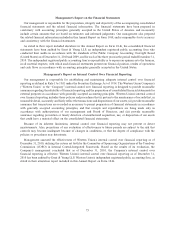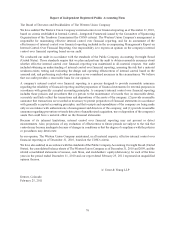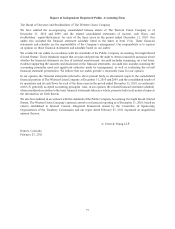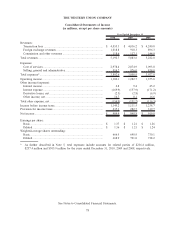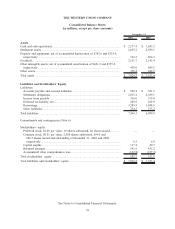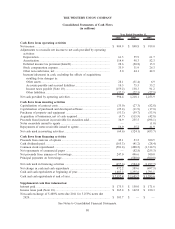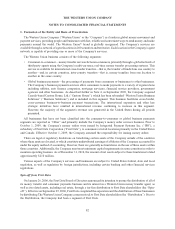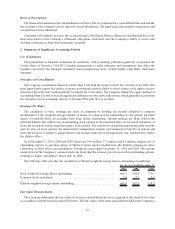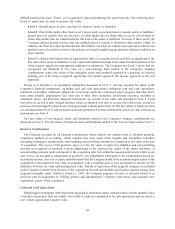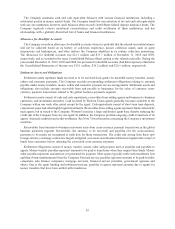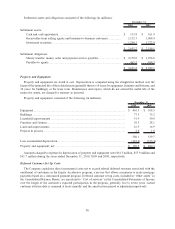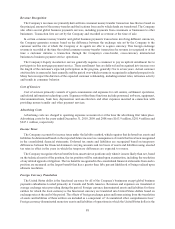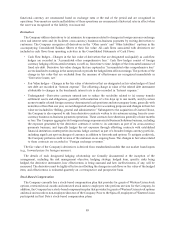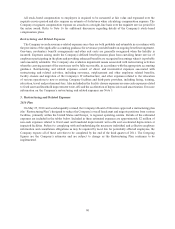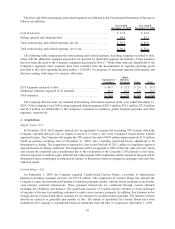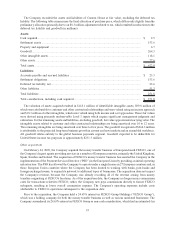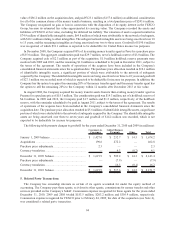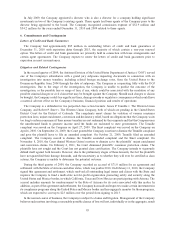Western Union 2010 Annual Report Download - page 87
Download and view the complete annual report
Please find page 87 of the 2010 Western Union annual report below. You can navigate through the pages in the report by either clicking on the pages listed below, or by using the keyword search tool below to find specific information within the annual report.The Company maintains cash and cash equivalent balances with various financial institutions, including a
substantial portion in money market funds. The Company limits the concentration of its cash and cash equivalents
with any one institution; however, such balances often exceed United States federal deposit insurance limits. The
Company regularly reviews investment concentrations and credit worthiness of these institutions, and has
relationships with a globally diversified list of banks and financial institutions.
Allowance for Doubtful Accounts
The Company records an allowance for doubtful accounts when it is probable that the related receivable balance
will not be collected based on its history of collection experience, known collection issues, such as agent
suspensions and bankruptcies, and other matters the Company identifies in its routine collection monitoring.
The allowance for doubtful accounts was $21.1 million and $33.7 million at December 31, 2010 and 2009,
respectively, and is recorded in the same Consolidated Balance Sheet caption as the related receivable. During the
years ended December 31, 2010, 2009 and 2008, the provision for doubtful accounts (bad debt expense) reflected in
the Consolidated Statements of Income was $19.1 million, $36.2 million and $26.6 million, respectively.
Settlement Assets and Obligations
Settlement assets represent funds received or to be received from agents for unsettled money transfers, money
orders and consumer payments. The Company records corresponding settlement obligations relating to amounts
payable under money transfers, money orders and consumer payment service arrangements. Settlement assets and
obligations also include amounts receivable from and payable to businesses for the value of customer cross-
currency payment transactions related to the global business payments segment.
Settlement assets consist of cash and cash equivalents, receivables from selling agents and business-to-business
customers, and investment securities. Cash received by Western Union agents generally becomes available to the
Company within one week after initial receipt by the agent. Cash equivalents consist of short-term time deposits,
commercial paper and other highly liquid investments. Receivables from selling agents represent funds collected by
such agents, but in transit to the Company. Western Union has a large and diverse agent base, thereby reducing the
credit risk of the Company from any one agent. In addition, the Company performs ongoing credit evaluations of its
agents’ financial condition and credit worthiness. See Note 7 for information concerning the Company’s investment
securities.
Receivables from business-to-business customers arise from cross-currency payment transactions in the global
business payments segment. Receivables (for currency to be received) and payables (for the cross-currency
payments to be made) are recognized at trade date for these transactions. The credit risk arising from these spot
foreign currency exchange contracts is largely mitigated, as in most cases Business Solutions requires the receipt of
funds from customers before releasing the associated cross-currency payment.
Settlement obligations consist of money transfer, money order and payment service payables and payables to
agents. Money transfer payables represent amounts to be paid to transferees when they request their funds. Money
order payables represent amounts not yet presented for payment. Most agents typically settle with transferees first
and then obtain reimbursement from the Company. Payment service payables represent amounts to be paid to utility
companies, auto finance companies, mortgage servicers, financial service providers, government agencies and
others. Due to the agent funding and settlement process, payables to agents represent amounts due to agents for
money transfers that have been settled with transferees.
85


